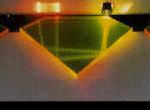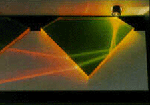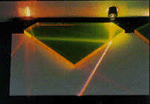Learn About Diamonds
Learn Important Facts about Diamonds
Diamond Color

It may surprise some people to learn that diamonds have color since many people know diamonds only as cut gemstones that are as clear as optical glass. But the truth is that the bulk of the diamonds on sale have a trace of color ranging from the barest hint to a strong hue. Like diamond cutting, determining the color of a diamond is a precise process and it affects the value of the stone.
Color in diamonds comes from chemical impurities in the stone and imperfections in its molecular structure. The variety of impurities that can be found is large enough to give the stone a potential array of colors, the predominant ones being yellow and brown.
This color is considered normal and does not mark one stone as immediately inferior to another. Diamonds with the most intense colors are referred to as "fancy color" diamonds and have names like cognac or champagne. In fact, the diamonds with the most extreme amount of color are more rare than those that are absolutely clear. A canary yellow diamond, for example, is prized by some for its rarity and therefore more expensive than a comparably-sized clear diamond.
This does not mean that diamonds that are absolutely free of impurities and imperfections are commonplace. Quite the opposite. Crystal-clear diamonds are quite valuable and highly sought-after because of their rarity as well as their beauty.
The four stones above demonstrate subtle differences in color with the corresponding grading scale below.
From left to right:
D-F: Absolutely colorless. This is the highest color grade and very rare.
G-J: Near to colorless. These appear colorless when mounted in white gold or platinum.
K-M: Diamonds in this category have a visible yellow or brownish tinge.
N-Z: Strong noticable color
Diamond Clarity

Clarity, as the name implies, refers to how clear the stone's material is, and what surface imperfections it may have. These have a direct effect on how light passes into a diamond and bounces around within it before finally exiting.
The internal flaws are called inclusions and they appear for several reasons. Most often inclusions are specks of foreign material within the diamond or even another diamond crystal inside or an imperfection such as a tiny crack in the structure of the mineral itself.
Surface imperfections are commonly called blemishes. These can be either major or minor and will affect the value of the stone accordingly.
Clarity is determined by the number, size, color, location, orientation and visibility of the inclusions and blemishes as seen under a 10X magnification. As mentioned earlier, flawless stones are very rare, so it is likely that you will be considering stones that are less than perfect. That's perfectly fine, particularly as many of these imperfections are scarcely visible to the naked eye and often only when you are scrutinizing the diamond very closely.
Here is how diamonds are graded for clarity: Flawless - No flaws internally or externally.
Internally Flawless - No flaws internally. This category of diamonds is also very rare and highly valued.
VVS1, VVS2 - Very, Very Slightly Included. Very difficult to see inclusions under 10x magnification.These diamonds are high quality.
VS1, VS2 - Very Slightly Included. Inclusions are not visible to the naked eye. This category is less expensive than the VVS1 or VVS2 grades.
SI1, SI2 - Slightly Included: Inclusions are visible under 10x magnification. This level of clarity is considered by many to be the best value buy because the inclusions are not visible to the naked eye. The prices for these diamonds are notably lower than those in clearer categories.
SI3 - Slightly Included-EGL: A borderline clarity category recognized by the EGL or European Gemological Laboratory .Diamonds in this category are likely to be graded by GIA as either SI2 or I1. EGL distinguishes these diamonds as having no black inclusions or cracks that are visible to the naked eye, but they may possess some very minor white inclusions which are visible to the naked eye.
I1 - Included: an I1 clarity diamond will have a visible flaw which can be seen with the unaided eye. If your budget is limited and you can only afford diamonds in the SI3 or I1 clarity, be sure to examine them under 10X magnification yourself before making the purchase. It will help you decide which one to buy. Any reputable jeweler would be happy to show you how to use a magnifier.
I2, I3 - Included: The inclusions in this category of diamonds will be visible to the naked eye. They will have many black spots from the black inclusions and may appear cloudy from the white inclusions and cracks.
Diamond Carat Weight

The size of the diamond is called it's carat weight and actually refers to its mass. All other characteristics being equal, the carat weight is the biggest determinant of the price of a stone.
A one carat diamond ring will always cost more than a ring made of smaller diamonds that weighs the same or even more.
Generally, once you have decided on cut, color and clarity, the next important decision is carat weight.
Tips to help you determine the right carat weight
Some considerations you will have to keep in mind:
- the size of the recipient's finger
- any personal preferences
- the type of setting
- the budget
Consider your purchase in this order: First, decide on to your budget and then explore the various qualities and designs available in that price range.
Factor in the shape of the finger. If the fingers are long, a small carat diamond may look even smaller and vice versa.
Be sure to match the setting of the diamond ring with the carat size. For example, a wide band can make a stone look smaller than it might with a narrower band. Keep in mind the word misfit when matching diamonds with settings and use your own judgment. Choose a setting that gives maximum protection to the diamond.
The lifestyle of the person wearing the diamond is also something to keep in mind. Someone who is very active will potentially subject a diamond ring to more knocks and scratches than a more sedentary person, particularly if the setting makes the stone stick out a lot.
Perhaps the only immeasurable consideration is personal preference. Without some really good intel, you might not be able to keep your diamond shopping a secret. But if someone says that she really likes champagne diamonds because they look nice with her skin tone, that is an excellent place to start!
Diamond Cut Because it is composed of a generally transparent material, diamond lets light pass through it, even in its most rough condition. But early on in history, stone cutters realized that you can get extra sparkle if you facet the diamond. So they set about finding out the best combination of facet size and shape and angle to get the most sparkle. Eventually, one design with 58 facets was shown to be the most efficient way to maximize the stone's best qualities and this became known as the ideal cut. It remains the industry standard, and is the shape that most people recognize as a diamond.
This does not mean that diamonds of the same size are equal when it comes to cut. A lot depends on the skill of the diamond cutter. The slightest variance in the angle of a single facet or its size or its effect on the symmetry of the stone will affect the diamond's value. Diamond cutting is an art but within the confines of exacting scientific boundaries.
This does not mean, however, that the diamonds that are cut to an ideal shape are automatically the best. Not at all. Part of the job of a highly skilled cutter is to determine what shape will be the best one to create the largest possible polished diamond from a given piece of rough. And rough diamonds come in all kinds of shapes. So a pear or emerald-shaped diamond has as much claim to being perfect as has the ideal cut, particularly if the pear or emerald cut produces a larger stone. In fact, most of the world's biggest, most famous diamonds are not ideal cuts because the chief goal was to maximize their size.
| A |
|
|
| B |
|
|
| C |
|
|
Clarity Enhancement
Color Enhancement
Irradiation Diamonds are bombarded with neutrons or electrons to change their color into a strong color. Sometimes these irradiated diamonds are then heat treated to further enhance the diamond's color.
The colors of the diamonds that are achieved by these methods are referred to as fancy colors. i.e. their color becomes strong yellow, green-blue and so on.
HPHT HPHT is real an abbreviaton for High Pressure and High Temperature, the extreme conditions used to change a diamond's color. Some very specific brown color diamonds will turn into white color diamonds under this process. A very small percentage of brown diamonds are suitable for this process.
It is also possible to get strong fancy colors like blue, yellow and pink under this process. Applying high pressure and high temperature, a colorless diamond will become a fancy color diamond.
In both cases the color change is permanent.
Diamond Fluorescence Fluorescence plays a crucial role in the pricing of diamonds. Just as diamonds that are yellowish when seen with the naked eye are lower in value than those that are clearer, diamonds with a yellow fluorescence are graded lower than diamonds without, and hence are less valuable.
On the other hand, diamonds showing a blue fluorescence are considered to have a higher quality than those with yellow fluorescence because the bluish white color more closely approximates the characteristics of colorless or near colorless diamonds.
The degree of fluorescence in diamonds varies a great deal and those with weak fluorescence are more desirable than those with a noticeable amount.
When buying diamonds, ask the jeweler for the certificate that accompanies the stone. It will disclose, among many other things, the amount of fluorescence, and that will directly impact the price. The certificate will indicate whether the diamond’s fluorescence is blue, white or yellow and if the diamond fluoresces very strongly, strongly, moderately or has a weak to faint fluorescence.
Here is the chart to help you in comparing the fluorescence diamonds prices in keeping with their color and clarity
| For D to H colors | IF to VS | SI1 to I3 |
| Very Strong Fluorescence | -8% to -12% | -3% to 0% |
| Strong Fluorescence | -5% to - 7% | -1% to 0% |
| Medium Fluorescence | -2% to - 4% | 0% |
| For I to N colors | IF to VS | SI1 to I3 |
| Very Strong Fluorescence | 0% to +4% | 0% to +4% |
| Strong Fluorescence | 0% to +4% | 0% to +4% |
| Medium Fluorescence | 0% to +3% | 0% to +3% |
| Slight to Faint | 0% to +1% | 0% |
Diamond Certification Having a grading certificate issued from a non-biased, third party laboratory on the diamond you are purchasing can be a very useful and valuable tool. However, you may notice that pricing among diamonds of the same carat weight, shape, color and clarity can vary greatly depending on the laboratory that issued that particular diamonds certificate. The scales of color and clarity used to grade diamonds were developed by the Gemological Institute of America (GIA). All laboratories use this scale, although not all use it to the same standard. What one laboratory grades a diamond for color and clarity may not be what another laboratory grades that same diamond. It is important to compare prices based on the same certificate. Diamond grading is subjective and at the discretion of the grader. Since price is directly related to quality factors (color, clarity and cut), accurate and honest grading is essential.
What does a diamond certificate say? A diamond certificate tells you all about the diamond. Known also as a diamond grading report or diamond dossier, the certificate discloses the 4Cs of diamonds' color, clarity, cut and carat weight.
In order to make the quality parameters of the diamonds even more visible and clear to the customers, the certificate also displays a plotted diagram of the diamond and its internal characteristics.
Today, there are a select few Gem Laboratories, and these are listed below.
 GSI - Gemological Science International (GSI) is an independent gemological organization committed to combining state-of-the-art technology with proven industry expertise and ethical integrity.
GSI - Gemological Science International (GSI) is an independent gemological organization committed to combining state-of-the-art technology with proven industry expertise and ethical integrity.
The only major gemological enterprise established in the 21st century, GSI has grown to become one of the largest gemological entities in the world, with offices spanning four continents.
 GIA - Gemological Institute of America is well known for grading system that it propagated across the world for diamonds. The certificates of this company are sought after by most jewelers as this is also one of the oldest and most reputed Laboratories and is very highly respected throughout the world.
GIA - Gemological Institute of America is well known for grading system that it propagated across the world for diamonds. The certificates of this company are sought after by most jewelers as this is also one of the oldest and most reputed Laboratories and is very highly respected throughout the world.
 IGI - International Gemological Institute was set up in 1975 in Antwerp and is known for its strict grading standards with its laboratories located in New York, Mumbai, Tokyo and Bangkok.
IGI - International Gemological Institute was set up in 1975 in Antwerp and is known for its strict grading standards with its laboratories located in New York, Mumbai, Tokyo and Bangkok.
 AGS - American Gem Society is one of the few diamond grading companies that keep strict quality standards. It's headquarter is in Nevada, USA.
AGS - American Gem Society is one of the few diamond grading companies that keep strict quality standards. It's headquarter is in Nevada, USA.
 EGL - European Gemological Laboratory has its labs opened in many cities including Johannesburg, New York, Antwerp, Paris, London, Seoul and Antwerp.
EGL - European Gemological Laboratory has its labs opened in many cities including Johannesburg, New York, Antwerp, Paris, London, Seoul and Antwerp.
 GCAL - Gem Certification and Assurance Lab (GCAL) is a diamond research and identification laboratory specializing in guaranteed diamond grading
GCAL - Gem Certification and Assurance Lab (GCAL) is a diamond research and identification laboratory specializing in guaranteed diamond grading
 HRD - Hodge Raad Voor Diamant, meaning the diamond high council has its headquarters in Antwerp. The company also represents diamond trade and industry of Belgium
HRD - Hodge Raad Voor Diamant, meaning the diamond high council has its headquarters in Antwerp. The company also represents diamond trade and industry of Belgium
 GGL is widely recognized as one of the world's premier scientific diamond grading laboratories. GGL provides diamond grading reports and appraisals for cutters, importers, wholesalers and jewelers throughout the United States. With state of the art gemological equipment and a staff of distinguished gemologists and appraisers, GGL is establishing elite standards in the world of diamond grading reports and appraisal.
GGL is widely recognized as one of the world's premier scientific diamond grading laboratories. GGL provides diamond grading reports and appraisals for cutters, importers, wholesalers and jewelers throughout the United States. With state of the art gemological equipment and a staff of distinguished gemologists and appraisers, GGL is establishing elite standards in the world of diamond grading reports and appraisal.
 PGSL - Professional Gem Sciences Laborotory is a full-service laboratory that provides appraisals, laser inscriptions on diamonds, Sarin reports, ?Origin of Color analysis, damage reports and much more. Originally established in 1980, PGSL have been servicing the jewelry industry as expert gemologists for 33 years and are located in Chicago Illinois.
PGSL - Professional Gem Sciences Laborotory is a full-service laboratory that provides appraisals, laser inscriptions on diamonds, Sarin reports, ?Origin of Color analysis, damage reports and much more. Originally established in 1980, PGSL have been servicing the jewelry industry as expert gemologists for 33 years and are located in Chicago Illinois.
Diamond Care Diamonds may be the hardest substance known to man and one of the most durable but that doesn't mean they are unbreakable or completely scratch-proof. You can, for example, chip a diamond if it makes contact with a hard surface with sufficient force. Such an occurrence would certainly significantly reduce the value of the stone.
A key component of diamond protection is the setting it is in. A diamond that is mounted on a ring that has elongated prongs is at more risk of being damaged or being popped out of the setting than one with a more modest setting. Keep that in mind when deciding on what you would like your ring to look like.
It is not widely-known outside of the jewelry industry but diamonds can be discolored, particularly by chemicals like chlorine or those found in hairspray. Brief contact with those compounds is not usually a problem but a gradual accumulation of these chemicals could discolor the gem.
Cleaning An ammonia solution a "one part ammonia to six parts water" is your best bet for cleaning diamonds. Apply it to your diamond jewelry and gently massage it by hand to loosen any dirt or contaminants. Do not use any commercial cleaning solutions or compounds that are not made specifically for jewelry even if they say that they are soft. They will not restore the sparkle the way that an ammonia solution or a professional cleaning done at your friendly, Preferred Jeweler can. Be careful, though about applying this solution to other gemstones as they have other properties and not all react well to ammonia. Consult with a professional if you have questions about how to treat other gems.
Storing It is also important to store your jewelry properly. There's a saying that only another diamond can break a diamond and it is somewhat true. (Other things can certainly break a diamond.) But you don't want to take a chance with yours so don't simply toss it into a pouch or box or drawer with other jewelry. Wrap the item in a soft cloth, like the kind often provided by jewelry stores. At the very least you could put each piece of jewelry in a small plastic bag so that it will have at least a minimal amount of protection from collisions with other jewelry. Remember, you have invested quite a bit of money into that diamond jewelry. Treat it properly and it will last for many generations.




 An excellent proportion cut of a diamond, would reflect light from one facet to another and then get dispersed from the top of the stone.
An excellent proportion cut of a diamond, would reflect light from one facet to another and then get dispersed from the top of the stone. The light escapes from the other side of the facet if the cuts in a diamond are made too deep.
The light escapes from the other side of the facet if the cuts in a diamond are made too deep. When the cuts are made too superficial, then the light escapes even before getting reflected
When the cuts are made too superficial, then the light escapes even before getting reflected